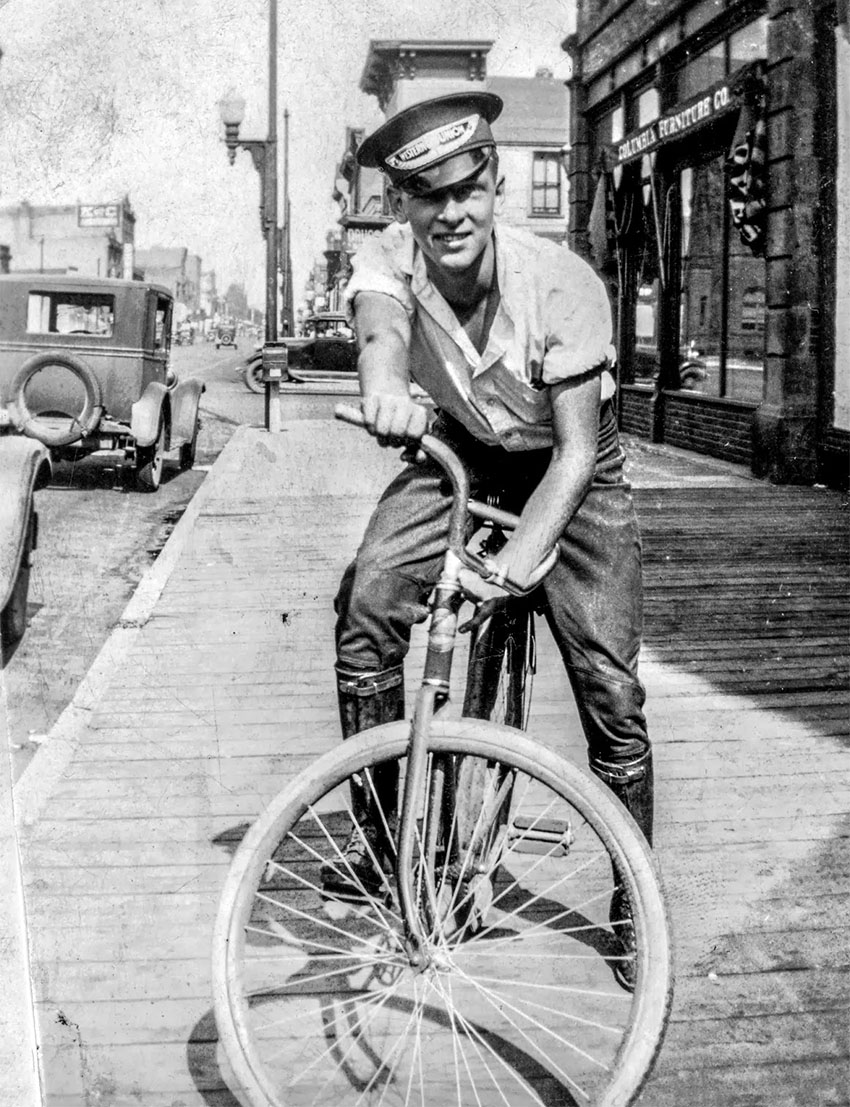

Since the late 1890s, when bicycles became readily available, Western Union messenger boys worked for low wages delivering telegrams by bicycle. It was often their first job. If they were lucky they could pick up tips to supplement their income.
It was notorious work. While waiting for the next message to come over the wires, they learned extra skills such as playing poker. Their jobs often involved delivering messages to bordellos.
Nevertheless, at times when jobs were scarce the company provided paid work for young boys who might otherwise have found it hard to make a living. These days this is often labelled ‘child labour’ …a perspective easy to adopt if you didn’t grow up in the early 20th century. Immigrants from Europe arrived in America from true poverty; by contrast, even low wages were an improvement.


1940s Western Union ‘Messenger Special’
22″ Frame
26″ Wheels
26 x 2″ Tyres
(Now sold)

This Western Union ‘Messenger Special’ is somewhat weathered and worn, but is nevertheless resplendent in red, white and blue and ready to see service again.
One side of its Western Union bicycle sign has a mark in the centre; the other side is clear.
New 26 x 2″ tyres and tubes have been fitted and the bike is overall good mechanical condition.


WESTERN UNION HISTORY

The New York & Mississippi Valley Printing Telegraph Company, now Western Union, began as a financial services and communications company in 1851. The firm expanded by buying out a number of competitive companies. In 1856, the company changed its name to Western Union Telegraph Company in anticipation of its ability to send telegraphs from the east coast to the west coast. The company completed its first transcontinental telegraph line in 1861, then went on to offer a variety of money- and time-related services to the public. In 1884, the company was one of the first 11 to list on the Dow Jones Transportation Average in the New York Stock Exchange.
When the new The New York and Mississippi Valley Printing Telegraph Company began operation, it was one of 50 that crisscrossed the northeastern states. There was no interconnection of lines. Messages were transferred by hand from one company to another, and rates were as high as $20 for a telegram (big money in those days).
The New York and Mississippi Valley Printing Telegraph Company set out to establish a unified, efficient service and carry it nationwide. During its first five years, the company acquired 11 other lines operating in five states north of the Ohio River and joined its eastern network with a telegraph line running as far west as St. Joseph Missouri.
On April 8, 1856, the name of the company was changed to The Western Union Telegraph Company, signifying the union of ‘western’ lines into one system.
With the outbreak of the Civil War, swift communication with the far West became essential. The only rapid communication beyond the Missouri River was by the Pony Express, which took 10 days to carry telegrams and mail from St. Joseph to Sacramento.
Although a telegraph line was needed, it seemed impossible to string a 2,000-mile line across the plains and over the rugged Rockies. Other telegraph companies refused to join in the undertaking, and even President Lincoln told Hiram Siley, Western Union’s president, “I think it is a wild scheme. It will be next to impossible to get your poles and materials distributed on the plains, and as fast as you complete the line, the Indians will cut it down.”
The first poles were set up on July 4, 1861, and day after day, following heavy wagons and herds of cattle, each team of builders stretched the line 10 or 12 miles farther across the nation.
The strands of iron wire, uniting the nation in rapid communication for the first time, were joined at Salt Lake City on October 24, 1861, only 112 days after the project was begun. Two days later, the U.S. government stopped using the Pony Express service and turned to the ‘lightning lines’ to speed messages across the continent.
Gradually, Western Union absorbed more than 500 telegraph companies throughout the nation, growing so much by 1884 that it was included in the original 11 stocks tracked in the first Dow-Jones Average. As the company expanded, it developed ingenious new services to keep pace with the changing needs of the American public.





















































